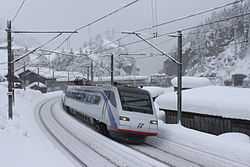Electric multiple unit
- See also: Light Rail vehicle (US usage)
An electric multiple unit or EMU is a multiple unit train consisting of self-propelled carriages, using electricity as the motive power. An EMU requires no separate locomotive, as electric traction motors are incorporated within one or a number of the carriages. Most EMUs are used for passenger trains, but some have been built or converted for specialised non-passenger roles, such as carrying mail or luggage, or in departmental use, for example as de-icing trains. An EMU is usually formed of two or more semi-permanently coupled carriages, but electrically powered single-unit railcars are also generally classed as EMUs.
EMUs are popular on commuter and suburban rail networks around the world due to their fast acceleration and pollution-free operation.[1] Being quieter than DMUs and locomotive-drawn trains, EMUs can operate later at night and more frequently without disturbing residents living near the railway lines. In addition, tunnel design for EMU trains is simpler as provisions do not need to be made for diesel exhaust fumes, although retrofitting existing tunnels to accommodate the extra equipment needed to transmit the power to the train can be expensive and difficult if the tunnel has limited clearance.
History

Liverpool Overhead Railway EMU carriage in the Museum of Liverpool, 2012
The first EMUs in were used on the elevated Liverpool Overhead Railway in 1893. The southern terminal of the railway was underground, giving the LOR the distinction of also being the first to use EMUs underground. Each carriage had an electric traction motor and was specifically designed and constructed to be light in weight while running on elevated steel sections. The first EMUs were two carriage trains later graduating to three carriages, with the front and rear carriages powered. Liverpool Museum retains an example of the Liverpool Overhead Railway EMU carriage.[2] An early proponent of EMUs was the American engineer Frank J. Sprague, who supplied them to the South Side Elevated Railroad in Chicago in 1897.
Types

Trains of the Singapore MRT. EMUs are often used for
rapid transit lines.
The cars that form a complete EMU set can usually be separated by function into four types: power car, motor car, driving car, and trailer car. Each car can have more than one function, such as a motor-driving car or power-driving car.
- A power car carries the necessary equipment to draw power from the electrified infrastructure, such as pickup shoes for third rail systems and pantographs for over head systems, and transformers.
- Motor cars carry the traction motors to move the train, and are often combined with the power car to avoid high-voltage inter-car connections.
- Driving cars are similar to a cab car, containing a driver's cab for controlling the train. An EMU will usually have two driving cars at its outer ends.
- Trailer cars are any cars that carry little or no traction or power related equipment, and are similar to passenger cars in a locomotive-hauled train. On third rail systems the outer vehicles usually carry the pick up shoes, with the motor vehicles receiving the current via intra-unit connections.
Examples
Some of the more famous electric multiple units in the world are high-speed trains: the Shinkansen in Japan and ICE 3 in Germany. The retired New York-Washington Metroliner service, first operated by the Pennsylvania Railroad and later by Amtrak, also featured high-speed electric multiple-unit cars.
Gallery
| Chennai Suburban Railway EMU, India |
| New Delhi Metro EMU in India |
| Indonesian EMU KL3 / Rheostatik 3 doors , services economy class for KRL Jabotabek |
| Belgian EMU AM80 "Break" unit |
| TSR double-decker train operate in Italy. LeNORD |
| Polish 14WE in Warszawa Śródmieście station |
| Metro-North Railroad M8 in Port Chester, New York |
| A South West Trains Class 450 at London Waterloo |
| An ETR 470 high-speed, tilting EMU negotiating the sharp curves of the Gotthardbahn. |
|
See also
References



















.jpg)






_Milan%2C_m%C3%A9tro%2C_ligne_2.jpg)



.jpg)